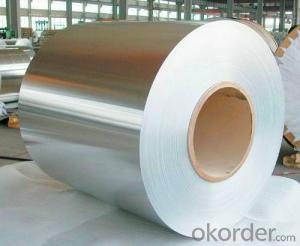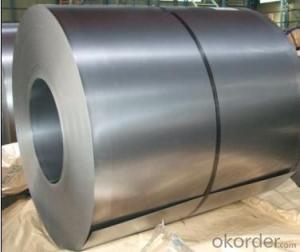Stainless Steel Coil 201 Hot / Cold Rolled Coil Narrow
- Loading Port:
- Lianyungang
- Payment Terms:
- TT OR LC
- Min Order Qty:
- 400 m.t.
- Supply Capability:
- 5000 m.t./month
OKorder Service Pledge
OKorder Financial Service
You Might Also Like
201 Hot Rolled Stainless Steel Coil Specifications
THK:2.3/2.5/3.0/4.0mm
Width:485/510/550/610/1010/1240mm
Face:No.1
201 Hot rolled stainless steel Coil Application
Stainless steel is a production which not easy rust,acid resistance and corrosion resistance,so it is widely
used in light industry,heavy industry,daily necessities and the decoration industry.
201 hot rolled stainless steel coil, use to produce cold rolled stainless steel coil and stainless steel tube, pipe.
201 Hot Stainless Steel Coil Chemical Composition(WT%)
(C):≤0.15, (Si):≤0.75, (Mn):5.5~7.50, (Cr):16.0~18.0, (N):≤0.25, (Ni):3.50~5.50, (P):≤0.060, (S):≤0.030
201 Hot Rolled Stainless Steel Coil
Strength Of Extension:100,000 To 180,000 Psi;
Yield Strength:50,000 To 150,000 Psi
Elongation :55 To 60%;
Modulus Of Elasticity:29,000,000 Psi;
Density :.280lbs/Cubic Inch(7.93g/Cm3)
- Q:What are the common surface treatments for stainless steel strips?
- Stainless steel strips can be treated in various ways to improve their appearance, durability, and resistance to corrosion. The following treatments are commonly used: Firstly, passivation involves chemically removing iron from the surface of stainless steel. This treatment creates a protective oxide layer, enhancing corrosion resistance. Secondly, pickling is a chemical process that eliminates impurities, scale, and oxides from the surface, resulting in a clean and uniform finish. Thirdly, electropolishing is an electrochemical method that removes a thin layer of material to enhance the smoothness and shine of stainless steel. It also reduces the risk of contamination and improves corrosion resistance. Furthermore, brushing is a mechanical treatment that uses abrasive brushes to create a textured or satin finish, helping to hide scratches and provide a decorative appearance. Additionally, grinding is another mechanical treatment that uses abrasive wheels to remove imperfections and create a smooth, polished finish. Lastly, coating stainless steel strips with protective films or paints can offer an extra layer of defense against corrosion, scratches, and other damages. These coatings can be clear or colored, depending on the desired aesthetic. Choosing the appropriate surface treatment is crucial, considering the desired outcome and specific requirements of the application. Each treatment has unique advantages and significantly enhances the performance and aesthetics of stainless steel strips.
- Q:Can stainless steel strips be used in the production of medical instruments for sterilization?
- Yes, stainless steel strips can be used in the production of medical instruments for sterilization. Stainless steel is a popular material choice for medical instruments due to its excellent corrosion resistance, strength, and durability. It is also highly resistant to heat and can withstand the high temperatures required for sterilization processes such as autoclaving. Additionally, stainless steel is non-reactive and does not leach any harmful substances, making it safe for use in medical applications. Therefore, stainless steel strips are a suitable material for the production of medical instruments that need to undergo sterilization.
- Q:How do stainless steel strips resist erosion in abrasive environments?
- Stainless steel strips resist erosion in abrasive environments due to their unique composition and protective oxide layer. The high levels of chromium present in stainless steel form a passive film on the surface, which acts as a barrier against corrosion and prevents direct contact of the metal with the abrasive materials. This oxide layer is self-healing, meaning it can repair itself if damaged, further enhancing the steel's resistance to erosion. Additionally, stainless steel's high strength and hardness make it more resistant to wear and tear, allowing it to withstand the abrasive forces present in harsh environments.
- Q:What is the thickness range for stainless steel strips?
- Depending on the specific grade and application, the thickness of stainless steel strips may vary. In general, these strips can be obtained in thicknesses ranging from 0.0015 inches (0.0381 mm) to 0.125 inches (3.175 mm). This extensive range provides versatility for their widespread utilization in industries like automotive, aerospace, construction, and manufacturing.
- Q:How do you prevent microbiologically influenced corrosion of stainless steel strips?
- Microbiologically influenced corrosion (MIC) is a common problem in various industries, including the corrosion of stainless steel strips. To prevent MIC and maintain the integrity of stainless steel strips, several preventive measures can be implemented: 1. Material Selection: Choose stainless steel grades that are resistant to MIC, such as 316L or higher-grade alloys. These alloys contain higher levels of molybdenum, which enhances their resistance to microbiological corrosion. 2. Proper Surface Finish: Ensure that the stainless steel strips have a smooth and polished surface finish. Rough surfaces provide crevices and pits where microorganisms can thrive and initiate corrosion. Regular cleaning and polishing can help maintain the smoothness of the surface. 3. Regular Cleaning and Maintenance: Regularly clean and sanitize the stainless steel strips to remove any biofilms or organic matter that can harbor microorganisms. Use industry-approved cleaning agents and techniques to eliminate potential sources of microbial growth. 4. Biocide Treatments: Apply appropriate biocides or antimicrobial coatings to the stainless steel strips. These treatments can inhibit the growth of microorganisms and prevent the initiation of corrosion. However, it is essential to select biocides that are compatible with stainless steel to avoid any adverse reactions. 5. Environmental Control: Maintain proper environmental conditions by controlling temperature, humidity, and the presence of corrosive chemicals. Microorganisms thrive in certain conditions, and by controlling these factors, the growth of microbes can be minimized. 6. Cathodic Protection: Implement cathodic protection techniques, such as impressed current or sacrificial anode systems, to provide an additional layer of protection against corrosion. These techniques can help mitigate the effects of MIC on stainless steel strips. 7. Regular Inspection and Monitoring: Conduct regular inspections to identify any signs of corrosion or microbial growth on stainless steel strips. Implement a monitoring program that includes visual inspections, microbiological testing, and corrosion rate measurements to detect any early signs of MIC and take appropriate actions. By implementing these preventive measures, the risk of microbiologically influenced corrosion on stainless steel strips can be significantly reduced, ensuring their longevity and performance.
- Q:How do stainless steel strips resist intergranular corrosion?
- Stainless steel strips resist intergranular corrosion primarily due to the presence of chromium in their composition. Chromium forms a protective oxide layer on the surface of the steel, which acts as a barrier against corrosive elements. This oxide layer is self-repairing, ensuring the strips retain their corrosion resistance even if damaged. Additionally, stainless steel strips are often alloyed with other elements such as molybdenum, which further enhances their resistance to intergranular corrosion.
- Q:Are stainless steel strips suitable for marine applications?
- Yes, stainless steel strips are highly suitable for marine applications. Stainless steel is known for its exceptional corrosion resistance, which makes it a preferred material for marine environments where exposure to saltwater, humidity, and other corrosive elements is common. Stainless steel strips have excellent strength and durability, allowing them to withstand harsh conditions, high temperatures, and mechanical stress commonly encountered in marine applications. Additionally, stainless steel's low maintenance requirements and aesthetic appeal make it a popular choice for various marine components such as boat fittings, marine hardware, marine fasteners, and shipbuilding.
- Q:What are the factors affecting the electrical resistivity of 111 stainless steel strips?
- The factors affecting the electrical resistivity of 111 stainless steel strips include the composition and purity of the stainless steel, temperature, and the presence of impurities or defects within the material. Additionally, the grain structure and crystallographic orientation of the stainless steel can also influence its electrical resistivity.
- Q:Can stainless steel strips be used for chemical processing equipment?
- Yes, stainless steel strips can be used for chemical processing equipment. Stainless steel is highly resistant to corrosion and can withstand exposure to various chemicals, making it a suitable material for manufacturing equipment used in chemical processing.
- Q:Can stainless steel strips be used for solar water heaters?
- Yes, stainless steel strips can be used for solar water heaters. Stainless steel is a durable and corrosion-resistant material that can withstand the harsh conditions of a solar water heating system. It is commonly used for the construction of the heat exchanger in solar water heaters, which is responsible for transferring the heat from the solar collector to the water. Stainless steel strips offer excellent thermal conductivity, ensuring efficient heat transfer and optimal performance of the solar water heater. Additionally, stainless steel is also resistant to scaling and mineral deposition, which can be common issues in water heating systems. Overall, stainless steel strips are a reliable and suitable material choice for solar water heaters.
1. Manufacturer Overview |
|
|---|---|
| Location | |
| Year Established | |
| Annual Output Value | |
| Main Markets | |
| Company Certifications | |
2. Manufacturer Certificates |
|
|---|---|
| a) Certification Name | |
| Range | |
| Reference | |
| Validity Period | |
3. Manufacturer Capability |
|
|---|---|
| a)Trade Capacity | |
| Nearest Port | |
| Export Percentage | |
| No.of Employees in Trade Department | |
| Language Spoken: | |
| b)Factory Information | |
| Factory Size: | |
| No. of Production Lines | |
| Contract Manufacturing | |
| Product Price Range | |
Send your message to us
Stainless Steel Coil 201 Hot / Cold Rolled Coil Narrow
- Loading Port:
- Lianyungang
- Payment Terms:
- TT OR LC
- Min Order Qty:
- 400 m.t.
- Supply Capability:
- 5000 m.t./month
OKorder Service Pledge
OKorder Financial Service
Similar products
New products
Hot products
Related keywords































